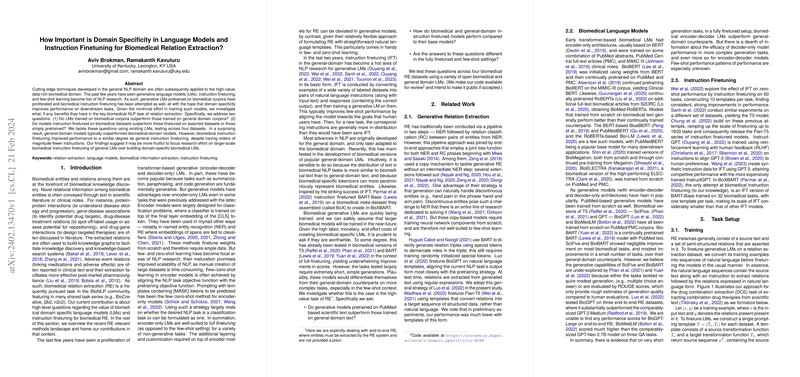Evaluating the Impact of Domain Specificity in LLMs for Biomedical Relation Extraction
Introduction to the Study
The intersection of generative LLMs (LMs) and the biomedical domain represents a fertile ground for enhancing tasks such as relation extraction (RE), a pivotal component in biomedical knowledge discovery. In an effort to investigate the necessity and effectiveness of domain-specificity in LMs and instruction finetuning (IFT) for biomedical RE, this paper explores two pivotal questions. Firstly, it assesses whether LMs pretrained on biomedical corpora exhibit superior performance over those trained on general-domain corpora. Secondly, it examines how models that have undergone IFT on biomedical datasets fare against those fine-tuned on more diverse datasets or those that have merely been pretrained. These inquiries are pursued through the lens of several existing LMs and tested across four biomedical RE datasets.
Biomedical Relation Extraction and LLMs
Relation extraction involves identifying semantic relationships between entities within a text, a process critical for constructing knowledge graphs and supporting various biomedical applications. Traditionally, RE and Named Entity Recognition (NER) tasks were accomplished using encoder models; however, generative models have shown promise in handling these tasks more flexibly through natural language prompts, particularly in few-shot learning scenarios. Concurrently, instruction finetuning has emerged as a method to align generative LMs towards specific task objectives, potentially enhancing their performance across various datasets.
Investigation and Methodology
The paper harnessed a selection of biomedical and general-domain LMs, including but not limited to variants of BART, T5, GPT-2, and BioGPT, alongside instruction-finetuned models like Flan-T5 and In-BoXBART. These models were evaluated in both full finetuning and few-shot settings across datasets such as CDR and ChemProt, which encompass diverse biomedical relations. Conversion of RE instances into natural language sequences facilitated the finetuning of generative LMs for the RE task at hand.
Key Findings
Surprisingly, the investigation revealed that general-domain models typically outperformed their biomedical-domain counterparts across most datasets and settings. However, models that underwent biomedical IFT showed performance improvements comparable to those achieved through general domain IFT, despite significantly fewer instructions. These findings prompt a reconsideration of the prevailing assumption that domain-specific pretraining universally yields better models for specialized tasks like biomedical RE.
Theoretical and Practical Implications
The results suggest that the advantages of domain-specific pretraining for RE tasks might be outweighed by the benefits derived from the broader, more diverse linguistic representations captured by general-domain LMs. Notably, the effective application of IFT, even with a limited set of biomedical instructions, underscores the potential of tailored model tuning over the development of domain-specific models from scratch. These insights advocate for a strategic pivot towards leveraging and refining existing general-domain LMs through targeted instruction finetuning, optimizing the balance between model performance and the resource-intensive process of model development.
Future Directions
This research opens avenues for further exploration beyond biomedical RE, encouraging the examination of domain specificity and IFT's impact across different fields and tasks. Moreover, expanding the scale and scope of biomedical IFT, potentially harnessing larger biomedical metadatasets, could unearth further enhancements in model performance. While the findings predominantly pertain to RE tasks, their implications could inform broader strategies in AI application development within and beyond the biomedical domain.
Conclusion
The nuanced approach of this paper, exploring the intricate dynamics between domain-specific pretraining, IFT, and RE performance, provides a foundational understanding for future AI research and development strategies. As the field evolves, continuous reassessment of these methodologies will be essential in harnessing the full potential of LMs across diverse knowledge domains.
